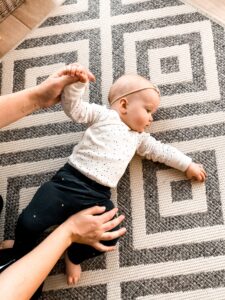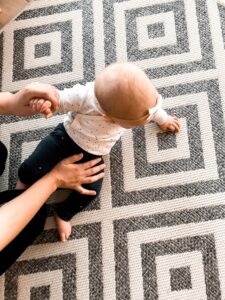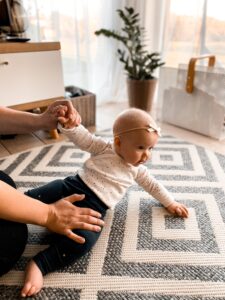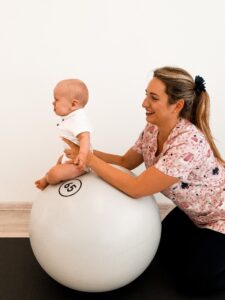Baby sitting is one of the most anticipated developmental milestones in the first years of life. A few decades ago, parents tended to rush this stage and often sat their children down too early, using pillows to support them. However, today’s health professionals recommend taking your time and waiting patiently until your baby is ready for this stage. Infant health experts stress that a child’s musculoskeletal system needs to develop gradually, so it’s important not to compromise the child’s developing posture and spinal health.
Parents notice the first signs that a baby wants to sit up as early as four months of age. At this age, the baby starts to roll forward, lifting its head upwards. Some babies do this while lying at an angle of 45-60 degrees or while their parents are holding them on their knees, while others do it even while lying on a flat surface. This is because the baby’s neck control and abdominal muscles have already improved. However, the sitting phase also requires other trunk muscles. So the abdominal muscles alone are not enough, and this desire to sit may not be enough for the sitting stage, according to parents. The baby should like lying on its tummy and be able to be pushed up against the support of straight arms. This indicates a strong shoulder girdle and strengthened back muscles, which are essential for a good sitting position. Strong back muscles will help your baby sit up straight. In addition, when the baby wants to reach for the toys in front when sitting, strong muscles will help the baby to straighten up after picking up the toys and return to a sitting position. Also, the baby should roll from back to stomach on both sides. This shows that the baby’s lateral trunk muscles are already strong. These muscles will be important for the baby’s sitting and balance. In addition, many babies reach their feet with their hands and begin to carry them to their mouths as they approach the sitting stage. This will show that the mobility of the hips is sufficient for the baby to sit, and that the baby’s legs will be comfortable to sit on and will provide a firm support.
In the fourth month, health professionals should perform a traction sample. It involves gently pulling the baby towards you while lying on your back, with your arms around the baby’s wrists. The baby should then want to lift his head, bring his chin to his chest and try to sit up.
In the fifth month, the baby has a straight arm support. The baby should be able to hold a sitting posture with the support of his/her arms when the test is carried out. However, at this stage the baby’s waist is still bent. So, at this age, we are only familiarising the baby with the sitting position, but we are not yet seating the baby. From around 5.5 months. we can teach your baby to sit sideways.
Exercise: teaching a baby to sit sideways
With the baby lying on its back, hold the leg bent over the knee and out to the side with one hand, and with the other hand hold the wrist of the opposite arm. Then gently lift and turn on its side and pull upwards. If your baby is ready to learn to sit up, he or she will lean on the base with his or her free hand and want to get up into a sitting position.



If the baby is ready and willing to sit up, we can slowly sit him on our laps or on the floor between our legs. In the beginning, it is important to hold the chest, play with the baby and help the baby to become stronger when sitting (see the example in the picture). It is very useful to exercise your baby with a gymnastics ball. This is to sit the baby on a ball and, with your arms around her waist and gentle pressure on the ball, roll the ball back and forth and left and right (see the example in the figure). It is very important to take your time and watch your baby trying to balance and develop trunk control.
This will gradually help the baby move towards independent sitting, gain trunk control and balance, and not fall. Babies learn to sit up independently between the sixth and ninth month. Guidelines from different countries state that if a baby is not yet sitting up at nine months of age, this is considered a red flag (warning sign) and referral to health professionals is recommended.
A baby learns to sit up a little later than when it is planted to sit. This can take up to 10 months. end. The baby can sit on its side or, if it is already crawling, from a four-point position, by turning backwards and putting the seat down. Sit-ups require coordinated work of the strong muscles of the trunk, and the lateral muscles of the trunk are particularly important here. It is therefore necessary to make sure that the baby spends a lot of time lying on its stomach and playing on its side.
Infants should be seated in assistive devices when they have already gained trunk control and do not roll to the side or sit with a hunched lumbar position when seated. For these reasons, some baby seat manufacturers recommend that babies should be placed in a highchair from the age of six months.
Research has shown that sitting development is closely linked to cognitive and language development. In general, motor development gives babies new opportunities to learn about the world around them, and improving motor skills leads to changes in perception, cognition and psychosocial development. Sitting speeds up the child’s cognition, analysis and learning of the environment, as well as the development of fine motor skills and variety of movement. It also influences the child’s perceptual development and accelerates the development of language skills. Developing independent sitting is essential for a child’s overall development. However, everything comes in its own time, so baby health experts recommend that you start developing sitting skills when your baby is ready.


Lect. physiotherapist Vaiva Selevičienė
Literature
- Kretch KS, Marcinowski EC, Hsu LY, Koziol NA, Harbourne RT, Lobo MA, Dusing SC. Opportunities for learning and social interaction in infant sitting: Effects of sitting support, sitting skill, and gross motor delay. Dev Sci. 2023;26(3):e13318. doi: 10.1111/desc.13318.
- Adolph KE, Franchak JM. The development of motor behaviour. Wiley Interdiscip Rev Cogn Sci. 2017;8(1-2):10.1002/wcs.1430. doi: 10.1002/wcs.1430.
- WHO Multicentre Growth Reference Study Group. WHO Motor Development Study: windows of achievement for six gross motor development milestones. Acta Paediatr Suppl. 2006;450:86-95. doi: 10.1111/j.1651-2227.2006.tb02379.x.
- Dosman CF, Andrews D, Goulden KJ. Evidence-based milestone ages as a framework for developmental surveillance. Paediatr Child Health. 2012;17(10):561-8. doi: 10.1093/pch/17.10.561.


